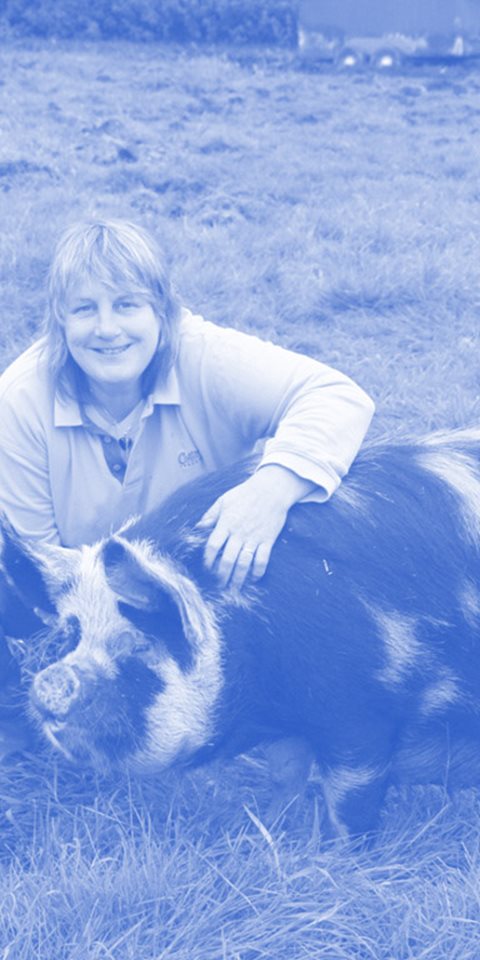POLICY BRIEF: Understanding attitudes to biosecurity in small scale pig keepers
1. KEY MESSAGES
Interviews with smallholders and crofters in Scotland that keep pigs, suggested that they have a good knowledge and understanding of the ‘peace time’ regulations around pig movement, feeding and general biosecurity. However, in some cases, regulations around carcass disposal are either misunderstood or not complied with.
There is some evidence from social media that levels of understanding of pig keeping regulations by pet* pig owners is less well defined.
*’Pet’, ‘mini’ or ‘micro’ pigs predominantly kept in urban areas in a similar way to pet dogs.
Interviews in 2020 with Scottish smallholders and crofters revealed that those who are raising pigs (and often other livestock), are knowledgeable about good general biosecurity. They know how to disinfect equipment, trailers, and footwear, and to change clothes when leaving their holding. However, contrary to regulations, some reported burying fallen stock on their premises.
Due to the nature of their premises, mainly rural and often off the ‘beaten track,’ the smallholders and crofters reported very little interaction with other pig keepers or livestock other than their own, unless attending livestock shows or sales.
Smallholders and crofters that breed pigs tend to have a permanent cohort of sows and a boar on site. The offspring either leave their holding to go directly to the abattoir or are sold to other smallholders as breeding stock or for finishing for slaughter.
Most of the smallholders and crofters interviewed had heard of African Swine Fever (ASF) and although some were unsure of the exact signs and symptoms, they were all certain that they would be aware (via social media, general media, government announcements or from their vets) of an ASF incursion in the UK.
Due to the small numbers of animals kept, and that pigs are often seen more as useful pets than a commercial commodity, smallholders and crofters tend to have a ‘hands on’ relationship with their animals. They stated that they would quickly know if a pig was ‘off colour’ or obviously ill and would call for veterinary attention, particularly if ASF was a national risk.
Due to the geographical remoteness of many holdings (locally and nationally), the lack of contact with other livestock and the apparent absence of feral pigs, the keepers interviewed considered their pigs to be at low risk of contracting ASF.
An additional brief review of Facebook pet pig groups suggests that there are a cohort of pet pig keepers that are either unaware of the regulations around pig keeping or believe that their pet pigs are exempt. There are also some keepers that show a lack of understanding of pig behaviour and good welfare. This may be an area for further research.
The objective of this study was to develop our knowledge of the attitudes and knowledge of biosecurity and ASF held by small scale pig keepers (smallholders, crofters, and pet/household pig keepers).
Whilst the smallholders and crofters interviewed had a good general knowledge and understanding of pig keeping regulations, it would appear that their knowledge of ASF in particular was lacking and in some cases their understanding of the correct procedures for carcass disposal was lacking or that they chose not to comply. This suggests that further communication may be required in these areas.
Some pet pig keepers posting on Facebook groups demonstrated working practices, around feeding regulations in particular, that are illegal. This may come from confusion around the wording ‘kitchen scraps or waste’ in the regulations, as some people buy food to prepare especially for their pigs thus are not feeding ‘scraps’.
As this area of the pet trade appears to be becoming more popular judging from the numbers of people joining groups on Facebook pages (e.g., mini pigs UK, 1.6k members), there may be concerns around biosecurity and the welfare of pet pigs.
Participants were recruited via Facebook groups and by the snowballing technique, where participants are asked to pass on the details of their contacts to be approached for further interviews.
This document highlights the outcome from 16 semi-structured interviews with Scottish smallholders and crofters aged between 31 and 65.
There was a good geographical spread of Scottish participants. Holdings ranged from approximately 2 acres to over 200 acres either on rough hill ground or more productive low ground. Experience of pig keeping ranged from novice keepers to highly experienced keepers. No keeper kept more than 15 adult pigs at any one time though many bred their pigs, so there were often more on the holding for short periods as piglets grew and were then sold. Although a small sample, saturation was reached in the 16 interviews i.e., no new information was being revealed in interview content.
A brief review of a pet pig Facebook group is not enough to make a definitive statement and further research with this group would be required to understand the current situation with this cohort.
EPIC Report: Understanding attitudes to biosecurity in small scale pig keepers.Kyle, Sutherland and Porphyre. April 2021
